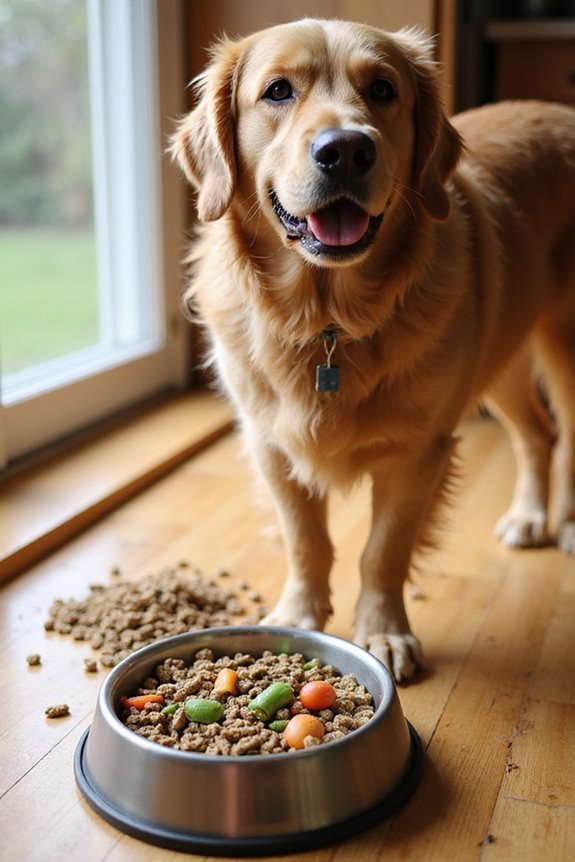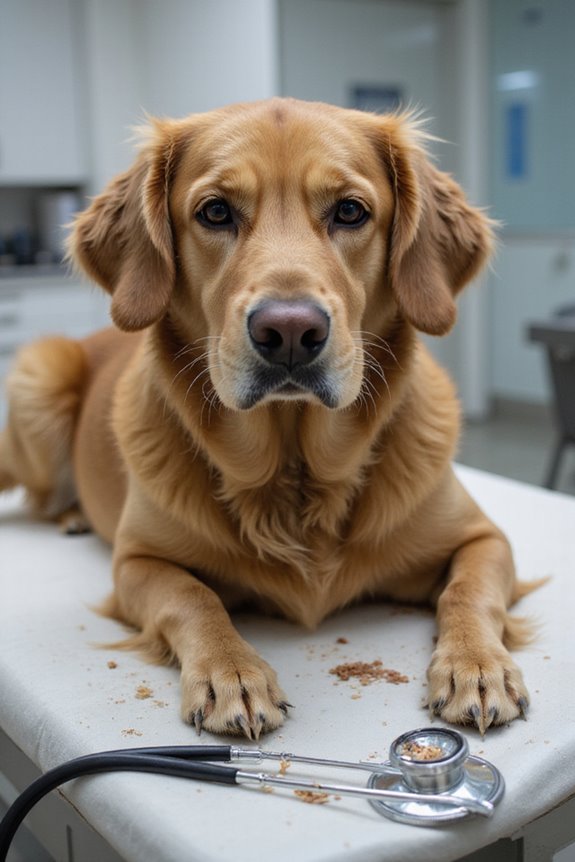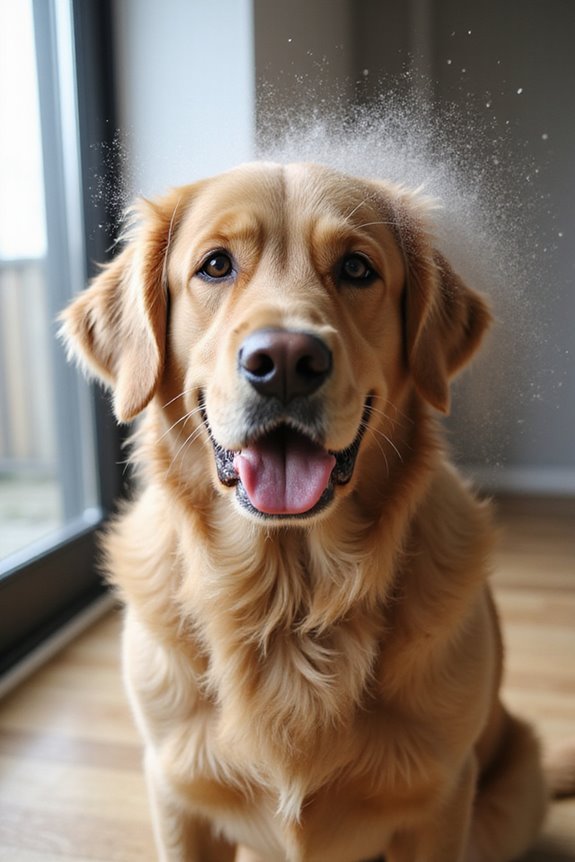If your dog is shedding excessively, several factors may be at play. It can be due to seasonal changes, as many breeds shed more in spring and fall. Diet plays an essential role; lack of protein and necessary fatty acids can worsen shedding. Additionally, health issues, like hormonal imbalances or nutritional deficiencies, might contribute. Environmental allergens could also irritate their skin, increasing shedding. Understanding these aspects will help you better manage your pet’s coat health and behavior.
Key Takeaways
- Seasonal shedding is natural, occurring in spring and fall as dogs change coats in response to daylight and temperature changes.
- Diet plays a critical role; low-quality food and lack of protein or omega-3s can increase excessive shedding.
- Health issues like hormonal imbalances, chronic illness, or nutritional deficiencies can cause increased shedding; consult a vet for assessment.
- Environmental factors, such as urban pollutants and allergens, can irritate a dog’s skin, leading to more shedding.
- Regular grooming helps manage shedding by removing dead hair and supporting coat health, tailored to your dog’s specific needs.
Seasonal Shedding Patterns
Seasonal shedding patterns are a natural and expected occurrence in many dog breeds, particularly as environmental conditions change. Most dogs go through shedding cycles during spring and fall, driven by hormonal responses to daylight and temperature fluctuations. In spring, dogs lose the dense winter undercoat, allowing for a lighter, cooler coat. Conversely, in autumn, they shed the summer coat to prepare for a thicker winter fur.
To effectively manage coat maintenance during these times, brush your dog regularly to remove loose fur and minimize mess. Pay attention to breed-specific characteristics, as double-coated breeds like German Shepherds typically experience heavier shedding. Understanding these cycles not only supports your dog’s comfort but also enhances their overall health and coat quality throughout the year. Regular grooming with the right grooming tools can significantly reduce shedding and improve coat health.
Diet and Nutrition Impacts

Maintaining a dog’s coat requires attention not only to seasonal shedding patterns but also to diet and nutrition impacts. An adequate intake of protein sources, like poultry or beef, is essential; insufficient protein can lead to excessive shedding. Furthermore, incorporating omega supplementation, particularly omega-3 fatty acids, is important for skin hydration and reducing inflammation, helping to minimize hair loss. Additionally, ensuring the omega-3 supplements contain EPA and DHA sourced from wild-caught fish can significantly enhance your dog’s coat health. It’s also critical to avoid filler ingredients in low-quality dog foods, which contribute little nutritional value and may worsen coat health. Food allergies can trigger allergic reactions resulting in shedding, necessitating careful monitoring and veterinary guidance. Finally, maintaining dietary stability is important, as sudden changes can stress your dog’s system, potentially leading to increased shedding over time.
Breed-Specific Shedding Differences

How do breed-specific characteristics influence shedding in dogs? Understanding shedding requires considering coat type. Breeds with double coats, like the Siberian Husky and German Shepherd, experience significant seasonal shedding. During spring and fall, they “blow” their coats, shedding heavily to adjust to temperature changes. This demands frequent grooming to manage the excess fur.
In contrast, dogs with short hair, like Labrador Retrievers, shed year-round but typically in smaller amounts. While they don’t require as much grooming, regular brushing still helps control the shedding. Choosing the right grooming tools, such as slicker brushes, can make the grooming process more efficient and effective.
It’s essential to recognize that larger breeds often shed more simply due to their size; however, coat type is a critical factor. Tailoring your grooming routine to your dog’s specific needs can greatly ease shedding frustrations.
Health and Medical Causes

Excessive shedding in dogs can often be an indication of underlying health and medical issues. Commonly overlooked, hormonal imbalances can stem from conditions like thyroid disease or Cushing’s disease, which disrupt the normal hair growth cycle. These disorders may lead to increased shedding or even patchy hair loss. Additionally, chronic illnesses such as diabetes or immune system disorders can further exacerbate this issue, as they impair nutrient delivery to hair follicles. Nutritional deficiencies in a dog’s diet can also negatively impact coat health, highlighting the necessity of a well-balanced, nutrient-rich diet. Joint health supplements can also support overall well-being and coat condition. Consulting with a veterinarian is crucial to determine the precise cause and guarantee appropriate treatment, allowing your dog to regain a healthy, beautiful coat.
Environmental and Lifestyle Factors

When considering why a dog might shed excessively, it’s essential to account for various environmental and lifestyle factors that influence coat health.
- Grooming Frequency: Regular grooming is vital. Infrequent grooming allows dead hair to accumulate, making shedding appear worse.
- Urban Pollutants: Dogs in urban settings face exposure to pollutants like vehicle emissions. This exposure can irritate the skin, leading to increased shedding.
- Seasonal Changes: Shedding peaks often align with changes in temperature and daylight, prompting dogs to shed their winter coats for a lighter summer coat.
- Activity Level: Active dogs may accumulate dirt and allergens in their fur, necessitating more frequent grooming to manage shedding effectively. Additionally, using grooming gloves can help reduce allergens by removing loose fur during these sessions.
Frequently Asked Questions
How Often Should I Groom My Dog to Manage Shedding?
I’ve found that grooming frequency is key for managing my dog’s shedding. Daily brushing with the right shedding tools makes a huge difference, especially during peak shedding seasons. Trust me, it really helps keep things tidy!
Can Certain Shampoos Help Reduce Shedding in Dogs?
You know, I stumbled upon these amazing shampoos recently, and wow—the nourishing ingredients really help my dog’s coat. With biotin and aloe vera, I’ve noticed a lot less shedding during bath time. It’s a relief!
Is Shedding Normal for Senior Dogs?
As my senior dog ages, I’ve noticed increased shedding, likely from normal coat changes and shedding causes like hormone shifts. It’s just part of their journey, but I always keep an eye on any unusual patterns.
Do Puppies Shed Less Than Adult Dogs?
I’ve noticed that puppies generally shed less than adult dogs. Their puppy coat is lighter and fluffier, leading to shedding differences. As they mature, I’ve found they tend to shed more, building a warmer coat.
How Can I Minimize Shedding During Seasonal Changes?
Let’s tackle minimizing shedding during seasonal changes together! I’ve noticed that diet changes, rich in omega fatty acids, can really help. Plus, keeping a close eye on weather effects and grooming regularly makes a significant difference.




